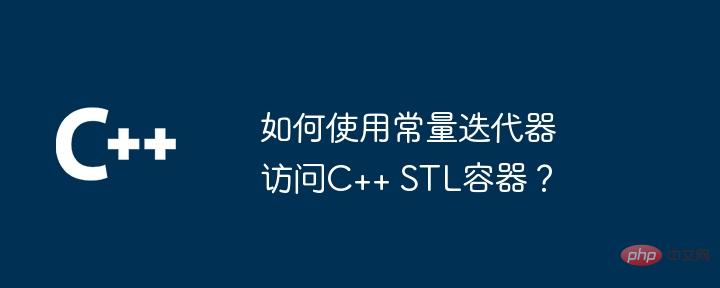答案:使用常數迭代器存取 STL 容器元素,無需修改內容。詳細描述:常數迭代器透過 cbegin() 和 cend() 方法獲取,用於遍歷容器而不修改元素。使用 * 運算子存取元素,傳回元素參考。使用 ++ 和 -- 運算子前進和後退迭代器。使用 == 和 != 運算子進行比較,判斷是否到達容器末端。

如何使用常數迭代器存取C++ STL 容器
在C++ 中,STL 容器提供了多種迭代器類型,包括begin() 和end() 方法傳回的常規迭代器,以及cbegin() 和cend() 方法傳回的常量迭代器。常量迭代器用於遍歷容器而不修改其內容。
語法:
常數迭代器與常規迭代器的語法相同。例如,在下列程式碼中,it 是一個指向vector<int> 容器中元素的常數迭代器:
const vector<int> v = {1, 2, 3, 4, 5};
const vector<int>::const_iterator it = v.cbegin();存取元素:
要存取常數迭代器指向的元素,可以使用* 運算子。與常規迭代器一樣,*it 傳回指向元素的參考:
cout << *it << endl; // 输出:1
#前進與後退:
##與常規迭代器類似,常數迭代器也可以使用++ 和-- 運算子進行前進和後退:
++it; // 前进到下一个元素 --it; // 后退到上一个元素
比較:##常數迭代器也可以用
== 和!= 運算子來比較:<div class="code" style="position:relative; padding:0px; margin:0px;"><pre class='brush:cpp;toolbar:false;'>if (it == v.cend()) {
cout << "迭代器指向容器的末尾" << endl;
}</pre><div class="contentsignin">登入後複製</div></div>
以下程式碼範例示範如何使用常數迭代器遍歷
vector 容器: 以上是如何使用常數迭代器存取C++ STL容器?的詳細內容。更多資訊請關注PHP中文網其他相關文章!#include <iostream>
#include <vector>
int main() {
const vector<int> v = {1, 2, 3, 4, 5};
// 使用常量迭代器遍历容器
for (const vector<int>::const_iterator it = v.cbegin(); it != v.cend(); ++it) {
cout << *it << " "; // 输出:1 2 3 4 5
}
return 0;
}




